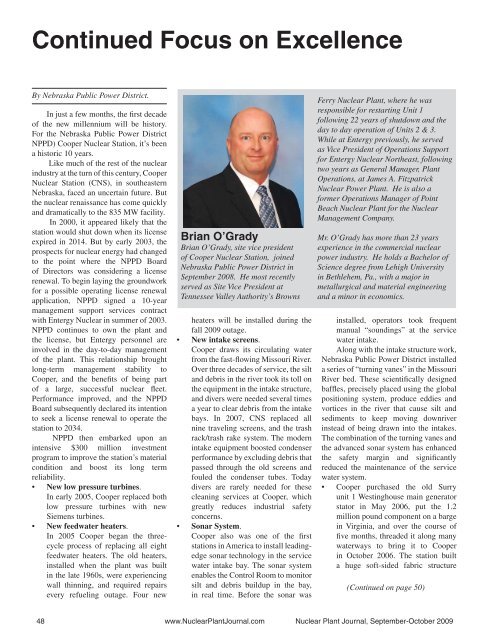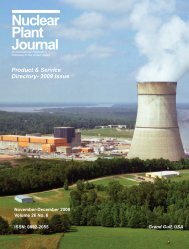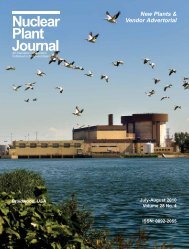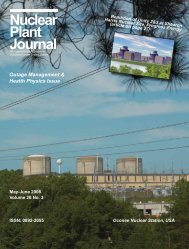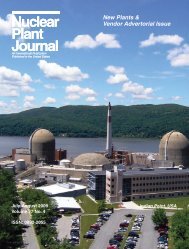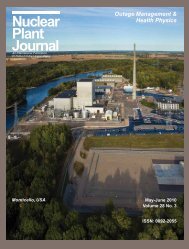Nuclear Plant Journal Nuclear Plant Journal - Digital Versions
Nuclear Plant Journal Nuclear Plant Journal - Digital Versions
Nuclear Plant Journal Nuclear Plant Journal - Digital Versions
- No tags were found...
Create successful ePaper yourself
Turn your PDF publications into a flip-book with our unique Google optimized e-Paper software.
Continued Focus on ExcellenceBy Nebraska Public Power District.In just a few months, the first decadeof the new millennium will be history.For the Nebraska Public Power DistrictNPPD) Cooper <strong>Nuclear</strong> Station, it’s beena historic 10 years.Like much of the rest of the nuclearindustry at the turn of this century, Cooper<strong>Nuclear</strong> Station (CNS), in southeasternNebraska, faced an uncertain future. Butthe nuclear renaissance has come quicklyand dramatically to the 835 MW facility.In 2000, it appeared likely that thestation would shut down when its licenseexpired in 2014. But by early 2003, theprospects for nuclear energy had changedto the point where the NPPD Boardof Directors was considering a licenserenewal. To begin laying the groundworkfor a possible operating license renewalapplication, NPPD signed a 10-yearmanagement support services contractwith Entergy <strong>Nuclear</strong> in summer of 2003.NPPD continues to own the plant andthe license, but Entergy personnel areinvolved in the day-to-day managementof the plant. This relationship broughtlong-term management stability toCooper, and the benefits of being partof a large, successful nuclear fleet.Performance improved, and the NPPDBoard subsequently declared its intentionto seek a license renewal to operate thestation to 2034.NPPD then embarked upon anintensive $300 million investmentprogram to improve the station’s materialcondition and boost its long termreliability.• New low pressure turbines.In early 2005, Cooper replaced bothlow pressure turbines with newSiemens turbines.• New feedwater heaters.In 2005 Cooper began the threecycleprocess of replacing all eightfeedwater heaters. The old heaters,installed when the plant was builtin the late 1960s, were experiencingwall thinning, and required repairsevery refueling outage. Four newBrian O’GradyBrian O’Grady, site vice presidentof Cooper <strong>Nuclear</strong> Station, joinedNebraska Public Power District inSeptember 2008. He most recentlyserved as Site Vice President atTennessee Valley Authority’s Brownsheaters will be installed during thefall 2009 outage.• New intake screens.Cooper draws its circulating waterfrom the fast-flowing Missouri River.Over three decades of service, the siltand debris in the river took its toll onthe equipment in the intake structure,and divers were needed several timesa year to clear debris from the intakebays. In 2007, CNS replaced allnine traveling screens, and the trashrack/trash rake system. The modernintake equipment boosted condenserperformance by excluding debris thatpassed through the old screens andfouled the condenser tubes. Todaydivers are rarely needed for thesecleaning services at Cooper, whichgreatly reduces industrial safetyconcerns.• Sonar System.Cooper also was one of the firststations in America to install leadingedgesonar technology in the servicewater intake bay. The sonar systemenables the Control Room to monitorsilt and debris buildup in the bay,in real time. Before the sonar wasFerry <strong>Nuclear</strong> <strong>Plant</strong>, where he wasresponsible for restarting Unit 1following 22 years of shutdown and theday to day operation of Units 2 & 3.While at Entergy previously, he servedas Vice President of Operations Supportfor Entergy <strong>Nuclear</strong> Northeast, followingtwo years as General Manager, <strong>Plant</strong>Operations, at James A. Fitzpatrick<strong>Nuclear</strong> Power <strong>Plant</strong>. He is also aformer Operations Manager of PointBeach <strong>Nuclear</strong> <strong>Plant</strong> for the <strong>Nuclear</strong>Management Company.Mr. O’Grady has more than 23 yearsexperience in the commercial nuclearpower industry. He holds a Bachelor ofScience degree from Lehigh Universityin Bethlehem, Pa., with a major inmetallurgical and material engineeringand a minor in economics.installed, operators took frequentmanual “soundings” at the servicewater intake.Along with the intake structure work,Nebraska Public Power District installeda series of “turning vanes” in the MissouriRiver bed. These scientifically designedbaffles, precisely placed using the globalpositioning system, produce eddies andvortices in the river that cause silt andsediments to keep moving downriverinstead of being drawn into the intakes.The combination of the turning vanes andthe advanced sonar system has enhancedthe safety margin and significantlyreduced the maintenance of the servicewater system.• Cooper purchased the old Surryunit 1 Westinghouse main generatorstator in May 2006, put the 1.2million pound component on a bargein Virginia, and over the course offive months, threaded it along manywaterways to bring it to Cooperin October 2006. The station builta huge soft-sided fabric structure(Continued on page 50)48 www.<strong>Nuclear</strong><strong>Plant</strong><strong>Journal</strong>.com <strong>Nuclear</strong> <strong>Plant</strong> <strong>Journal</strong>, September-October 2009


